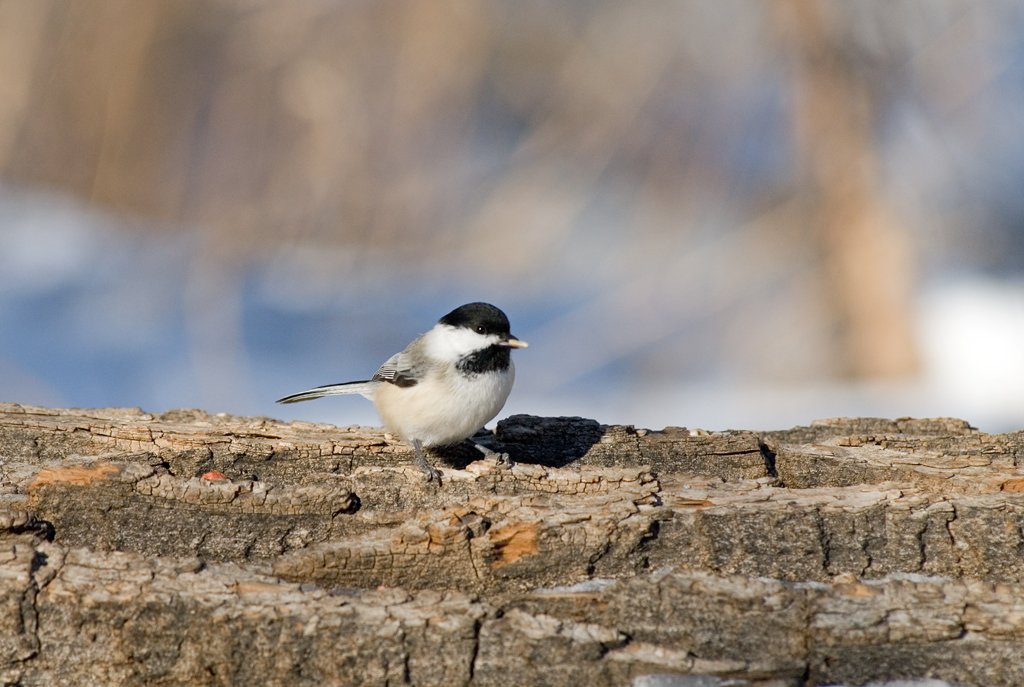September Nature Almanac: Caching in for a Living – Food Hoarding Behaviors of Colorado Birds
By Scott Severs, with Stephen Jones and Ruth Carol Cushman
September 2022
As the last few leaves fall from the trees, and snow levels begin to rise, our thoughts often turn to the wildlife outside our homes and their adaptations to survive the extremes of winter. One such adaptation involves caching, or storing, food for later use.
Conifer seeds, especially from pine and spruce trees, and wild fruit are cached away. Birds that commonly hoard food include ravens, crows, jays, chickadees and nuthatches. There is some evidence that Hairy and Downy Woodpeckers cache food too.
Black-capped Chickadee with seed. Photo by Stephen Jones.
Birds begin to store food around the end of August, and caching reaches peak levels in September, coinciding with the ripening of fruits and seeds. Members of the Corvid family, including jays, magpies, and nutcrackers, stockpile most of their winter rations in autumn. Special adaptations in their throats and esophagi allow these birds to carry away scores of seeds and fruits. Jays have expandable esophagi in which several nuts can be carried (watch a video of a Blue Jay holding many peanuts at once in its esophagus). Sometimes a Blue Jay will take three to five acorns into its throat and then proceed to take two more acorns in its bill. The record holder for transporting seeds in a single journey belongs to the Clark's Nutcracker. A voluminous sac, known as a sublingual pouch, allows nutcrackers to transport from 20 to nearly 90 limber pine seeds each time! The pouch is located on the floor of the mouth, with an entrance under the tongue (watch a Clark’s Nutcracker forage and store food in its pouch).
Jays and nutcrackers store their bounty in rock or tree crevices, or small holes dug into the soil with their bills. The birds add three to five seeds per hole, push them into place with their bill, and cover them with loose soil and leaf litter. Proficient at seed storage, a single nutcracker caches upwards of 100,000 pine seeds in nearly 25,000 sites scattered over several square miles. Caches are located on south-facing or wind-swept slopes that generally have less snow. The seeds from pinyon, ponderosa, and whitebark pine comprise over three-fourths of their winter diet and continue to be important in spring for feeding young nutcrackers.
White-breasted Nuthatch. Photo by Stephen Jones.
Chickadees and nuthatches also hoard pine seeds. Unlike jays, these birds lack the specialized mouthparts for transporting food. The corvids carry food in from outside their normal territory, but chickadees and nuthatches travel shorter distances while finding and hiding food within their home range and thus have no need to transport as much as jays do in their mouths. Bits of seeds and collections of insects are pushed into bark crevices. Nuthatches will use additional pieces of bark and lichen to conceal their food from cache robbers.
How do the birds remember where they stashed all the food they harvested in the past autumn? Most research points to a highly developed spatial memory, the ability to find objects in relation to their distance from other objects. Studies conducted by Stephen Vander Wall at Utah State found that nutcrackers in captivity would remember their cache in relation to certain rocks. If the rocks were moved a specific distance, the nutcrackers would similarly search an equally displaced amount. Chickadees are amazing, replacing old brain neurons with new ones to remember thousands of new seasonal caches.
Clark’s Nutcracker. Image by Stephen Jones.
Birds rarely recover all the stored food, as they tend to store more than they would eat in one season. This often benefits the trees that nutcrackers and jays forage on, as un-recovered seeds may grow into mature trees. Several pines depend on nutcrackers for survival and have coevolved to utilize the food-storing habits of these birds to ensure new generations of trees.
Caching behavior is particularly easy to observe in the autumn and within winter flocks. Chickadees make good subjects as they’re easily approached. Jays are always entertaining! They often compete with squirrels for cache locations. The jays steal from the squirrels, who, in turn, steal back from the jays.
Other September Events
Migration peaks for songbirds and raptors. Look in foothills thickets for thrushes, warblers, and sparrows filling up on insects to add fat for migration. Watch especially along hogbacks for falcons, Accipiters (forest hawks), and Buteos (soaring hawks).
Bears, raccoons, foxes, coyotes, and birds forage on wild plums and chokecherries.
Elk rut begins with bulls competing for herds of cows and young males anxiously waiting on the periphery of older bulls’ territories.



